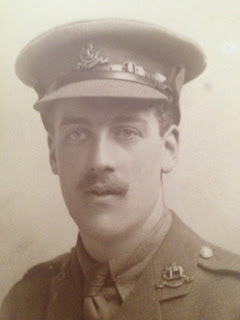 |
| Sgt. Norman Roberts |
Contact details
There seems to be a continuing issue with the 'Comment' feature on the site, so if you do wish to get in touch, you can always make contact via e-mail to greatwarworkshops@gmail.com
Friday 30 September 2016
Sunday 1st October 1916
Thursday 29 September 2016
Saturday 30th September 1916
 |
Brig. Genl. T.S. Lambert
Image by kind permission of Juliet Lambert
|
 |
Pte. Thomas Robinson (16490), seated.
Image by kind permission of Gary Robinson
|
Wednesday 28 September 2016
Friday 29th September 1916
 |
| Sgt. Norman Roberts |
A pension award was made in respect of the late Pte. Harry Briggs (16040) (see 17th May), who had been killed in action in March; his widow, Ada, was awarded 18s. 6d. per week.
Tuesday 27 September 2016
Thursday 28th September 1916
 |
| Lt.Col. S.S. Hayne |
 |
2Lt. Bob Perks, DSO
Image by kind permission of Janet Hudson
|
Pte. John Henshall (see 16th July) who had been wounded in July, was transferred from Edinburgh War Hospital to the Royal Victoria Hospital, Netley, for further treatment for ‘neurasthenia’.
.Monday 26 September 2016
Wednesday 27th September 1916
Pte. James Bradley (18319) (see 6th June) was admitted to 5th General Hospital at Rouen, suffering from ‘trench fever’.
Pte. Thomas Ward (see 23rd December 1915) was admitted to hospital; the reason for his admission and the length of his stay are unknown.
Sunday 25 September 2016
Tuesday 26th September 1916
 |
Lt. Dick Bolton
Image by kind permission of Henry Bolton
|
In a letter home to his wife, Brig. Genl. T.S. Lambert (see passim) commented on the improved weather and also shared his observations on the current state of affairs:
 |
Brig. Genl. T.S. Lambert
Image by kind permission of Juliet Lambert
|
Official notice of the award of the DSO to 2Lt. Bob Perks (see 24th September) was published in the London Gazette:
Temp. 2nd Lt. Robert Clement Perks, W. Rid. R.
For conspicuous gallantry during operations. When leading a bombing party, he was wounded in the face and rendered insensible. On recovering, he again took part in the attack. While throwing bombs he was again twice wounded, in the hand and foot, but continued to lead his men till rendered unconscious by a fourth wound in the face.”
 |
2Lt. Bob Perks, DSO
Image by kind permission of Janet Hudson
|
Enquiries continued regarding 2Lt Roland Herbert Wyndham Brinsley-Richards (see 22nd September) who was officially reported ‘missing in action’ following the attack on Munster Alley. A statement was taken, at no.10 General Hospital, Rouen, from Pte. A. Dean. He reported, “I was with the machine gun at Horseshoe Trench near Contalmaison (sic. this was actually 5th July). Mr. Richards led the Company over the parapet and on the tiop of the German parapet he was shot by machine gun fire. I saw him shot. We were about 200 yards behind, and when I got in the trench I saw his body”.
 |
| 2Lt. R.H.W. Brinsley-Richards |
Saturday 24 September 2016
Monday 25th September 1916
Pte. William Frederick Ackrill (see 11th September 1915) was admitted via 1st (Northumbrian) Field Ambulance to a Rest Station (details unknown). He was suffering from “P.U.O” (pyrexia, or high temperature, of unknown origin); this would subsequently be ascribed to influenza.
Friday 23 September 2016
Sunday 24th September 1916
 |
| A Daily Mail postcard depicting troops clearing roads through Contalmaison |
Pte. Albert Saville (see 3rd June) was injured and had to be evacuated for further medical treatment. Saville “was sitting in a trench when shell struck parapet and he was buried in fall of earth”. He was taken to 1st General Hospital at Etaples.
Pte. Arthur Hodgson (see 17th June) was evacuated to England having been wounded at some point (date and details unknown).
 |
Brig. Genl. T.S. Lambert
Image by kind permission of Juliet Lambert
|
Lt. Thomas Beattie, (see 14th September), who had been wounded in July while serving with 9DWR, was released from Western General Hospital in Manchester following his recent operation to remove shrapnel from his shoulder. He was granted six weeks’ leave.
Thursday 22 September 2016
Saturday 23rd September 1916
 |
Capt. H.M.S. Carpenter
Image by kind permission of Henry Bolton
|
Henry Wain died, aged two; he was the youngest of four children of Cpl. Harry Wain (see 29th May), who had died of wounds in March.
Wednesday 21 September 2016
Friday 22nd September 1916
 |
Capt. J.C. Bull
Image by kind permission of the Trustees of the DWR Museum
|
Mrs. Marian Carpenter, mother of the late of Capt. Herbert Montagu Soames Carpenter (see 4th September), who had been killed in action on 5th July, wrote to the War Office to explain her situation in regard to the estate of her son;
 |
Capt. H.M.S. Carpenter
Image by kind permission of Henry Bolton
|
 |
| Pte. Reuben Smith |
 |
| L.Cpl. Willie Waggitt |
 |
| 2Lt. R.H.W. Brinsley-Richards |
 |
| Pte. Sam Tinkler |

